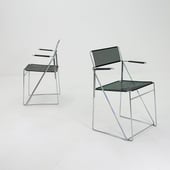
Set of 2 X-Line Armchairs by Niels Jørgen Haugesen for Hybodan AS, 1970s

Pair of X-Line Armchairs by Niels Jørgen Haugesen for Hybodan AS, 1970s A timeless pair of X-Line armchairs, designed by Niels Jørgen Haugesen ...
$$$$$ · Indexed March 9, 2025 · Source
etsy.com
Content may be subject to copyright. Terms of Use
Midage Vintage 2
Germany
Still looking? Try a search.




